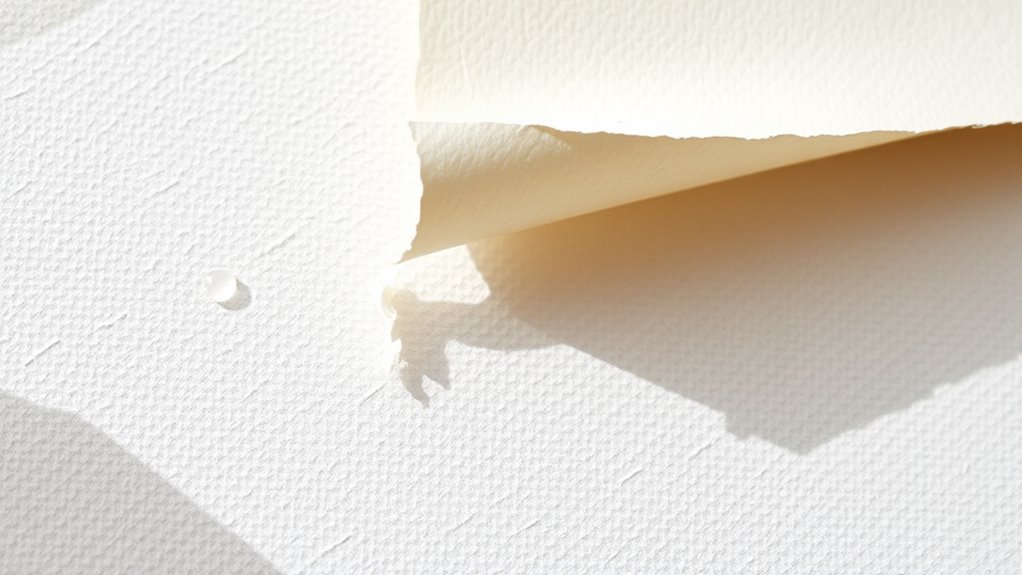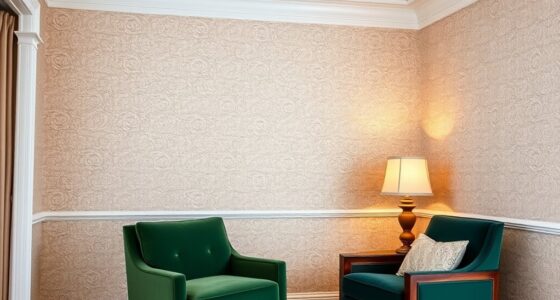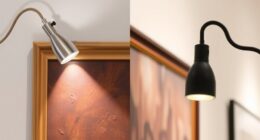To handle wallpaper shrinkage on drying, guarantee you apply it smoothly and avoid stretching or pulling during installation. Maintain a consistent, moderate environment—use fans on low or open windows, and steer clear of direct heat sources. Properly drying takes patience; rushing can cause gaps and wrinkles. Using high-quality materials and following manufacturer instructions also helps reduce shrinkage. To discover more effective tips for dealing with this common issue, keep exploring solutions tailored to your project.
Key Takeaways
- Use gentle, indirect drying methods like fans on low or open windows to promote even drying.
- Maintain consistent temperature and humidity to prevent rapid surface drying and uneven shrinkage.
- Avoid direct heat sources such as hair dryers or heaters that can cause material pulling or wrinkles.
- Allow sufficient drying time before making adjustments or finishing to minimize gaps and misalignments.
- Select high-quality wallpaper and follow manufacturer instructions to reduce shrinkage issues during drying.

When wallpaper dries, it often shrinks slightly, which can lead to visible gaps or misalignments. This common issue happens because of the wallpaper material and the drying techniques you use. Understanding how different materials behave during drying can help you minimize shrinkage. For example, vinyl wallpaper tends to be more stable, while paper-based options are more prone to shrinking. Knowing your wallpaper material allows you to choose appropriate drying methods and anticipate potential issues.
Wallpaper may shrink slightly as it dries, leading to gaps or misalignments depending on material and drying methods.
The key to managing shrinkage starts with the drying process itself. If you rush the drying, you increase the chance of uneven shrinkage and gaps forming. Instead, employ gentle drying techniques. Use a fan set to a low setting or open windows to promote airflow without creating direct blasts of hot air, which can cause the wallpaper to dry unevenly. Avoid using heat sources like hair dryers or heaters directly on the wallpaper, as rapid drying can cause the material to pull away from the wall or develop wrinkles.
It’s also important to contemplate the environment. Maintaining a consistent temperature and humidity level helps the wallpaper dry evenly. If your space is too humid, the drying process slows, and the wallpaper might stay damp longer, increasing the risk of shrinkage once it finally dries. Conversely, very dry conditions can cause rapid surface drying, leading to surface cracks and misalignments. Using a dehumidifier or humidifier as needed can create the ideal environment for drying.
Another factor is your wallpaper application technique. Ensuring a smooth, bubble-free application and proper smoothing during installation helps reduce the chances of visible gaps as the wallpaper shrinks. If you notice any misalignments during drying, avoid pressing or stretching the material further. Instead, wait until the wallpaper is fully dry before making adjustments. This prevents further damage or distortion.
In some cases, slight shrinkage is unavoidable, especially with certain paper-based wallpapers. To mitigate this, you might consider applying a sizing solution before installation, which can help stabilize the wallpaper material during drying. Additionally, choosing high-quality wallpaper and following manufacturer recommendations for drying time and techniques can make a significant difference. Patience is key—allow the wallpaper enough time to dry thoroughly before finishing your project.
Implementing proper drying techniques based on your wallpaper type and environmental conditions can significantly reduce the chances of noticeable shrinkage and ensure a professional finish.
Frequently Asked Questions
How Can I Prevent Wallpaper Shrinkage Before Installation?
To prevent wallpaper shrinkage before installation, make sure you properly prepare the surface, cleaning and smoothing it thoroughly. Choose the right adhesive, preferably one designed for shrinkage-prone wallpapers, and follow the manufacturer’s instructions carefully. Allow the wallpaper to sit at room temperature before hanging, and avoid overly humid environments. These steps help the wallpaper adhere well and minimize shrinkage, giving you a smooth, professional finish.
What Types of Wallpaper Are Most Prone to Shrinking?
You’ll find that natural fiber wallpapers, like linen or silk, are most prone to shrinking, especially if you don’t choose the right adhesive or prep the surface properly. These materials tend to react to moisture and humidity, causing contraction. To minimize this, use a high-quality adhesive suited for delicate fabrics and guarantee your wall is thoroughly primed. Opting for vinyl or paper-based wallpapers can also help reduce shrinkage risks.
Does Temperature Influence Wallpaper Shrinkage During Drying?
Yes, temperature effects considerably influence wallpaper shrinkage during the drying process. When the air is too warm, the adhesive and wallpaper fibers dry too quickly, causing uneven shrinkage and potential warping. Conversely, cooler temperatures slow the drying process, allowing the wallpaper to settle evenly and reduce shrinkage. To minimize issues, maintain a stable, moderate temperature while drying, avoiding rapid temperature changes that can worsen shrinkage.
Are There Specific Adhesives That Minimize Shrinkage?
Sure, some adhesives are so clever they claim to minimize shrinkage—yet, ironically, no adhesive can completely prevent it. But if you want the best shot at shrinkage prevention, choose adhesives specifically formulated for this purpose, like vinyl or heavy-duty pastes. These options provide better flexibility and stronger bonding, which help reduce the chances of noticeable shrinkage. Remember, even the best adhesive can’t perform miracles, but it’s worth trying!
Can Wallpaper Shrinkage Be Reversed After Drying?
Yes, wallpaper shrinkage can be reversed after drying. You should carefully use removal techniques to peel the edges without damaging the paper. Once loose, you can reapply the wallpaper using proper reapplication methods, such as light pressing and smoothing, to help stretch the material back into place. Applying a damp cloth or gentle heat may also aid in relaxing the adhesive, allowing you to correct the shrinkage effectively.
Conclusion
So, while wallpaper shrinkage might seem like a setback, it’s actually a sign you’ve done your job well. As the paper tightens on the wall, it reveals a fresh, smooth finish—like a canvas awaiting its masterpiece. Embrace the change, knowing it’s part of the process. Just as a seed must shrink to grow into a flower, your patience during drying guarantees your wall will soon be flawless and beautiful, ready to impress.









